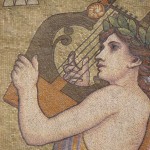Music and dance have been central features of theater for millennia. Ancient Greek and Roman plays included songs and choreography, and the Middle Ages saw traveling minstrels perform musical morality plays, but neither of these eras had much direct influence on today’s musical theater. Later, Shakespeare’s plays and Molière’s farces included music and dance, too, but the first direct ancestors of the Broadway musical arose in the late Italian Renaissance: commedia dell’arte and opera. Those are the dual threads that eventually spun into what we now call musical theater.
In the early 18th century, Italian opera saw the rise of opera-buffa, a variation on the form that included spoken dialogue and lighter music. Near the end of the century, Mozart brought the comic opera to new heights in Vienna, but the revolution truly took hold in Paris with its opéra-comique (later opéra-bouffe), the French translation of the form. In fact, the Opéra-Comique theater was originally called Le Théâtre Italien.
In England, comic opera took a romantic turn, while commedia gave birth to English pantomime, a vital part of British music hall tradition. These operas and pantos were two of the primary types of musical entertainments on U.S. stages until the mid-19th century, when P.T. Barnum and other producers began translating these forms for American audiences along the Bowery, which quickly became New York’s premiere theater district.
Over the next few weeks, I’ll present a more detailed account of the rise of stage and film musicals. In the meantime, take a look at the two dozen shows (and four dozen suggestions for further exploration) that I’ve reviewed in the past few weeks.
Stage musicals
1. Show Boat (then Porgy and Bess and The Mikado)
2. Oklahoma! (then Annie Get Your Gun and Pal Joey)
3. Guys and Dolls (then Kiss Me, Kate and The Pajama Game)
4. My Fair Lady (then Hello, Dolly! and Oliver!)
5. West Side Story (then The Music Man and Bye Bye Birdie)
6. Gypsy (then Carnival and Nine)
7. The Fantasticks (then Little Shop of Horrors and The Threepenny Opera)
8. Fiddler on the Roof (then Man of La Mancha and Les Misérables)
9. Cabaret (then Rent and Urinetown)
10. A Chorus Line (then Dreamgirls and Dear Evan Hansen)
11. Sweeney Todd (then Evita and Ragtime)
12. Hamilton (then Wicked and The Book of Mormon)
Screen musicals
1. 42nd Street (then Love Me Tonight and Snow White and the Seven Dwarfs)
2. Top Hat (then Swing Time and Pinocchio)
3. The Wizard of Oz (then Girl Crazy and Holiday Inn)
4. Yankee Doodle Dandy (then Stormy Weather and Seven Brides for Seven Brothers)
5. Meet Me in St. Louis (then Cover Girl and Easter Parade)
6. An American in Paris (then Funny Face and Summer Stock)
7. Singin’ in the Rain (then The Band Wagon and Gigi)
8. A Star Is Born (then Jailhouse Rock and New York, New York)
9. Mary Poppins (then Yellow Submarine and The Muppet Movie)
10. All That Jazz (then Fame and Nashville)
11. Beauty and the Beast (then The Lion King and The Nightmare Before Christmas)
12. Frozen (then Moulin Rouge! and La La Land)
Another good survey of musical history is Broadway: The American Musical, home of the 2004 PBS series, which has a companion book by Laurence Maslon. Also check out New Line Theatre’s YouTube channel, which has several playlists of historical videos, as well as the book Making Musicals (1998) by Tom Jones, a good introduction not only for learning about musicals but also making them, and the video Broadway’s Lost Treasures (2006), with clips from 40 years of Tony Awards.
For screen musicals, try Rough Guide to Film Musicals (2007) by David Parkinson and the video That’s Entertainment! (1974), which features 30 years of highlights from the MGM vaults, many from the legendary Freed Unit.
Here’s some vocabulary as you explore the world of musical theater: ballad, song style where music is most prominent; charm song (rhythm song), song style where music and lyrics are equally prominent, e.g., “The Surrey with the Fringe on Top” from Oklahoma!; comedy song, song style where lyrics are most prominent; dramatic scene (production number), song style where words shift between dialogue and lyrics, e.g., “Dancing Through Life” from Wicked; diegetic song, a song performed as a song, often in backstage musicals, e.g., “Take Back Your Mink” from Guys and Dolls; interpolated song, an old song used in a new show, often in jukebox musicals, e.g., “Good Morning” from Singin’ in the Rain; and trunk song, a song written but unused in one show that is rewritten and used in another show, e.g., “Come What May” from Moulin Rouge!

